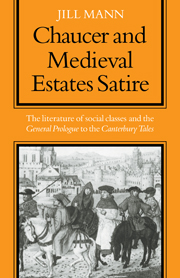Book contents
- Frontmatter
- Contents
- Preface
- List of Abbreviations
- Note on References
- 1 Introduction
- 2 The Anti-Clerical Tradition in Estates Satire
- 3 Estates Ideals
- 4 The Omission of the Victim
- 5 Independent Traditions: Chivalry and Anti-Feminism
- 6 Descriptive Traditions: Beauty and the Beast
- 7 ‘Scientific’ Portraits
- 8 New Creations
- Excursus: The ‘General Prologue’ and the ‘Descriptio’ Tradition
- 9 Conclusions
- Appendices
- Notes
- Selected Bibliography and List of Works Cited
- Index
6 - Descriptive Traditions: Beauty and the Beast
Published online by Cambridge University Press: 23 October 2009
- Frontmatter
- Contents
- Preface
- List of Abbreviations
- Note on References
- 1 Introduction
- 2 The Anti-Clerical Tradition in Estates Satire
- 3 Estates Ideals
- 4 The Omission of the Victim
- 5 Independent Traditions: Chivalry and Anti-Feminism
- 6 Descriptive Traditions: Beauty and the Beast
- 7 ‘Scientific’ Portraits
- 8 New Creations
- Excursus: The ‘General Prologue’ and the ‘Descriptio’ Tradition
- 9 Conclusions
- Appendices
- Notes
- Selected Bibliography and List of Works Cited
- Index
Summary
The rhetorical descriptio does more than provide the form of the Prologue portraits; its conventional uses contribute something to their content. In this chapter, I shall discuss the portraits of the Prioress and the Summoner. The links between the Prioress' portrait and descriptions of romantic heroines have been fully recognised, but it is not usually realised that the Summoner is linked in a similar way with conventional descriptions of ugliness. In what follows I shall not only discuss these links with the descriptio tradition, but shall try to show how Chaucer incorporates the descriptive material into his presentation of the estate.
THE PRIORESS
The traditional description of a romantic heroine accounts for almost all the external features included in the Prioress' portrait.
Ful semyly hir wympul pynched was,
Hir nose tretys, hir eyen greye as glas,
Hir mouth ful smal, and therto softe and reed;
But sikerly she hadde a fair forheed;
It was almoost a spanne brood, I trowe;
For, hardily, she was nat undergrowe. (151–6)
This description, in outline and detail, reproduces the appearance of a worldly beauty. Moreover, the Prioress is called, romantically, ‘madame Eglentyne’ (121). Her ‘smylyng’ Chaucer describes as ‘symple and coy’ (119)– a pair of adjectives that J. L. Lowes has shown are applied over and over again to the heroines of Old French romance. Her behaviour is also consonant with the lady of a castle rather than the head of a nunnery:
At mete wel ytaught was she with alle:
She leet no morsel from hir lippes falle,
Ne wette hir fyngres in hir sauce depe;
Wei koude she carie a morsel and wel kepe
That no drope ne fille upon hire brest. […]
- Type
- Chapter
- Information
- Chaucer and Medieval Estates Satire , pp. 128 - 144Publisher: Cambridge University PressPrint publication year: 1973



